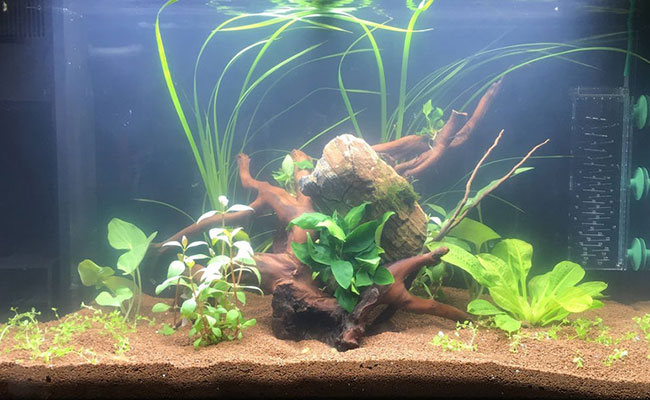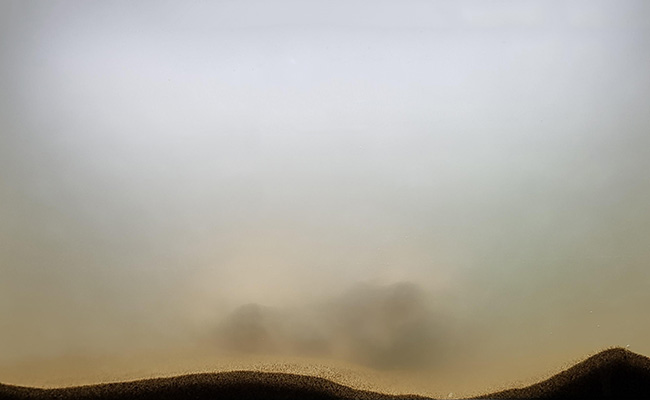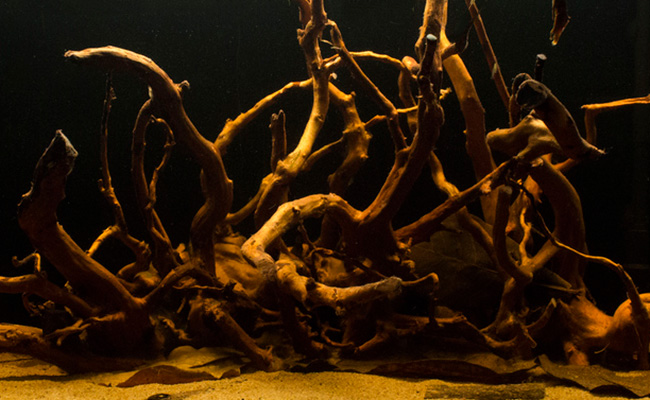How to Make My Fish Tank Green Cloudyclear Again
Are you staring at your cloudy fish tank in disgust?
It doesn't have to be this way!
Today, I am going to accept you through the common causes of cloudy water and how to get rid of cloudy fish tank for good.
Every fish lover and hobbyist has gone through the dreadful episode of encountering cloudy h2o.
Autonomously from having an uninviting look, these grayness aquarium tanks can pose various threats to the fish and the aquatic microclimate in your aquarium.
If yous wish to see your fish healthy and thriving, we recommend paying close attention to your cloudy water issue and solving information technology as soon as possible.
But first, accept a closer look at that fog in your tank and tell me what colour it is…
Annotation: Consider filling a articulate glass mug with the tank's water to inspect the correct color and find the reason corresponding to it.
White cloudy water in aquarium
If your mug showcases milky white h2o, and so chances are y'all are either dealing with bacterial bloom or unwashed substrate.
Your h2o can also have a few visible particles if it turns wholly or partially opaque.
Sometimes, y'all tin barely see information technology, a slight grayish haze…

Other times, it looks more like milk than water.

Seriously, there are fish in there… Somewhere.
Hither are the reasons why your aquarium looks like it has been blanketed in white fog…
1. Unwashed substrate
Every aquarium needs a colorful substrate batch to add vibrancy to the tank; however, y'all will soon notice cloudy white h2o if the new gear up is unwashed.
Adding new gravel creates remainder or specks of clay, making the water whiteish murky in color. If your substrate is extremely dirty, the tank can also showcase a gray tone instead of a white.
Moreover, hobbyists should never forget that large pebbles practise not make excellent substrates for your fish tank. The food you feed often gets lodged between these pebbles, and your fishes cannot reach such cramped spots.
This uneaten lodged food eventually produces DOCs or dissolved organic compounds in your aquarium.
Did you forget to wash your substrate earlier adding information technology to your established aquarium?
If the partial water turns cloudy within couple hours of setting upwardly your aquarium, then this is probably why.
You encounter, gravel and sand substrates comprise actually fine specks – created when information technology rubs together…
Now, these grit-similar pieces are and so small that you lot won't even detect them at commencement. Even so, when added to light-green water, they split from the larger pieces of substrate and bladder around your mature aquarium.
The event?
A very visible and ugly haze.
I know it's too tardily now, but this is why yous should wash sand and gravel substrates before adding them to your aquarium – information technology removes the fine dust.
Cause(s)
- The leading crusade of cloudy white water is unwashed substrate or residue from gravels, rocks, and other substrates.
How to become rid of it!
To go rid of the cloudy water, yous can try a few solutions. A quick gear up is to change your water entirely, then all the floating particles and little clay pieces get removed from your tank.
The next step is to accept out your gravel and clean it thoroughly. Nosotros highly recommend giving your new substrates a consummate thorough rinse before introducing them to your aquarium.
If your aquarium has a h2o filter cartridge with a fine mechanical medium like filter floss, you can avoid changing the h2o. The filter floss volition hands trap all the dust floating in your tank, resulting in a clean tank with clear water. Hobbyists tin also have the help of whatever water clarifier to accelerate the cleaning process.
If you can run into a thin layer of dust accumulated on the bottom of your tank, avoid disturbing the water. Instead, employ a gravel vacuum to remove all the particles settling in a higher place, between, and beneath the substrates. Subsequently, y'all tin can apply a water clarifier to clean the water, making it crystal articulate.
Gravel and sand rest is perhaps the easiest cause of cloudy water in aquarium to ready. A h2o change volition help remove a portion of the dust that is floating around your tank…
Even so, the all-time solution is to but wait. If your aquarium h2o filter cartridge uses a fine mechanical media, such as filter floss, then information technology volition eventually trap most of the grit that is floating. You could also use a good h2o clarifier to speed up the procedure.
Now, it's likely that a small corporeality of the dust will settle on the floor of your tank. This grit will again kick dorsum up into the water if it's disturbed. Non to worry! This can easily be removed with a quick gravel vac – check out our gravel vacuum review to find the perfect one for your tank.
two. Bacterial blossom
Bacterial bloom is notwithstanding another issue deemed extremely mutual when the water in your tank turns exceptionally cloudy. When your aquarium is riddled with bacterial bloom or blossom, it often resembles a tank total of diluted milk.
This phenomenon occurs when your tank has backlog nutrients, fish waste, or decaying food in the h2o and a limited quantity of beneficial leaner to swallow it. This situation tips off the system and forces the bacterial colony to reproduce more than. The explosion of the population oftentimes makes the h2o take a milky haze.
If your h2o looks like a thick white fog, and then you lot might be dealing with a bacterial flower. Yep, that hazy deject could actually be millions of tiny beneficial bacteria, swirling effectually your tank.
On its own, a single leaner is invisible. Withal, equally they grow in number, the grouping looks like a foggy discoloration in your aquarium.
Gross, huh?
What you are looking at is commonly called abacterial colony.
Bacterial blossom is a common sight when cycling your aquarium. In some cases, it will be a mild haze, while in others, your aquarium tin await like it'southward filled with milk – it all depends on how many leaner there are.
Cause(south)
- The leading cause can be introducing harmful chemicals or medications that are prone to impale or deplete the benign bacterial colony in your tank.
- Sudden ammonia spikes from any organic waste produced past your fish tin also outcome in bacterial bloom.
- A new tank that hasn't been appropriately cycled can also event in milky h2o.
- A new large grouping of fish can cause this event if your tank doesn't have enough beneficial bacteria to support the tank'southward ecosystem.
- Replacing the old filter system with a new filter tin also cause this issue.
How to get rid of information technology!
You do nil. In a cycling tank, this bacterial blossom volition disappear on its own. A week afterward, your cloudy water volition be nothing more a afar memory.
If y'all are non cycling your tank, then a bacteria bloom could be a big alarm sign. Y'all see, this bacteria commonly appears when decaying plants, rotting fish food or too much poop builds upwardly in your tank.
If that's the case, the first affair you desire to do is catch your trusty aquarium test kit.
Got information technology? Skillful. Now, you need to check your ammonia and nitrite level to make sure they are both at zero parts per meg (ppm).
If they have risen, perform an immediate water change and then that no harm comes to your fish. At present, you lot have to figure out what the cause was.
This cloudy looking bacteria often appears when at that place is too much fish waste breaking down. The most mutual cause of this is overfeeding your fish. Non only will your fish poop more than, simply there volition exist uneaten fish food source rotting at the lesser of the tank syndrome – set up this past cut back feedings and removing all the uneaten backlog food and decomposable excess waste product from your tank.
Another cause could be that y'all accidentally killed off all the good leaner in your cloudy fish tank. If you rinsed your aquarium filter media in tap water, the chlorine will kill the expert bacteria, and you will have to cycle your aquarium all once more, with your fish notwithstanding within.
If you accept changed your tank's water recently, that tin be a large reason for bacterial bloom. To get rid of this, wait for a week or two.
The cloudiness of your water tank should start to gradually articulate up as soon equally the tank's bacteria reestablish again, thus forming a perfect aquatic system. Avoid changing your water constantly or using UV sterilization every bit information technology can further increase your upshot of bacterial bloom.
However, if you feel that the leaner blossom is caused by other factors like substrates, excess waste, or decaying food, perform a fractional h2o change. One can besides use a gravel vacuum to eliminate the tiny particles floating in your tank. Partial water modify is the key here as it won't damage the existing bacterial culture.
Greenish cloudy h2o in aquarium

Out of all the dissimilar colored clouds that will visit your tank, greenish cloudy aquarium water makes beginners panic the most. Information technology just doesn't look right, like pea soup.
If you inspect your water in a clear cup and see a shade of light-green, then the primary culprit is algae bloom. This issue is prevalent in tanks that receive sunshine daily.
In severe cases, your water will exist so murky that you can barely see your fish.
So, what is this weird light-green fog that covers your aquarium?
Well, it turns out that it's a particular blazon of algae bloom…
Algae Bloom
Any aquarist with lilliputian experience with aquariums knows how common algae flower is. Algae is a fully living microorganism that grows on the sides of your tanks and nether/on the tank's decoration.
These algae can profusely multiply if ignored, resulting in a tank full of green-shade water. Ane must note that algae always thrives on the verbal requirements of whatever plant.
You will see a massive spike in algae growth if your tank has sufficient nitrogen and sunlight. Excessive feeding or fish waste tin can create extensive nitrogen, thus inviting algae to proliferate.
Since algae are living organisms, overpopulation of them tin can surely disturb your aquarium's ecosystem and touch the fish and plants in your tank. Lastly, apart from changing the colour of your tank, information technology volition rapidly deplete the oxygen levels of your tank at night.
Phytoplankton is small.Really small-scale. In fact, you can't see information technology with your naked eye. But as it grows in number, it will becomevery noticeable, turning your tank water a cloudy green color.
But don't worry! While information technology may not be pleasant to look at, this blazon of algae growth won't damage your fish.
Crusade(s)
- If your aquarium is directly exposed to stiff sunlight, information technology will cause the algae to bloom uncontrollably.
- Switching on artificial aquarium lights for an extended catamenia tin can also crusade this result of algae bloom.
How to get rid of information technology!
One must perform a water modify as it is the most vital stride to get rid of algae flower. Afterwards, address the overstocking or overfeeding to bring the spread in command.
The above remedy is to make clean the water by changing the entire water volume of your tank. This stride won't reduce the algae growth permanently, so you demand to motility the location of your tank to a less sunny place.
If you utilize artificial lights, consider turning them off to foreclose the algae from overpopulating. The terminal method uses a UV sterilizer to eliminate the algae-ridden h2o.
Ultraviolet radiation changes the algae'due south cell structure, discouraging the algae from reproducing on a cellular level. Afterwards sterilizing, you can change your water and remove all the algae.
A UV sterilizer or fine filter media, like a polishing pad, will quickly put an cease to this greenish cloudy mess for adept – your water will be crystal clear in no time.
While this will fix the problem – the algae – information technology doesn't cease the cause.
Unfortunately, there are a lot of different causes…
- Dirty filter
- Not performing water changes
- Also much light
- Carbon dioxide (CO2) deficiency
- Imbalanced fertilizers
Nigh of the time, one of these is responsible for your murky water. Sort these out to forbid the green deject from coming back!
Yellow or dark-brown cloudy h2o

If your mug test shows a tint of brownish or yellowish cloudy water, and so the sole reason is the introduction of untreated driftwood in your aquarium.
While it might start out equally a yellowish tinge, if you don't finish it, your water will darken in color until it looks like a refreshing sweetness tea.
The likely culprit?
Untreated Driftwood
Many aquarium hobbyists like to introduce natural driftwood in their aquarium to make the tank look appealing and exciting while giving their fishes something to rasp or crumb on.
We highly recommend calculation driftwood to your tank as it is exceptionally helpful in dropping the pH of your water. This dropping of pH is an excellent way to naturally make hard water more gentle and suitable for most fish species.
So if you have recently introduced a new piece of driftwood in your aquarium, then it is the only reason for such yellowish-chocolate-brown murky water.
Driftwood generally leeches tannins into the h2o, which gives it the brownish shade. The h2o first goes through a yellow tint and, with time, can plough into a deep brown color, resembling a shade of muddied water or exotic sugariness tea.
This hue can likewise be acquired by introducing leaves and seed pods into your tank. While these tannins aren't necessarily dangerous for your fish, they can make the tank look muddy and obstruct the fish'south vision.
As the tannins slowly leach into your aquarium, information technology will turn your water a yellowy brown colour.
FishLab Fact: Some aquarists want their aquarium to plough a brown colour, adding untreated driftwood and leaves to darken the water. These tanks are known every bit blackwater aquariums, and while they may non appeal to everyone, they are beautiful when designed correctly.
Cause(due south)
- The just crusade of dark-brown-yellow h2o is keeping pieces of untreated driftwood, leaves, or seed pods in your tank.
How to get rid of it!
This tip is beneficial when you decide to alter your driftwood. Consider pre-soaking and and so boiling the forest before placing it in your aquarium tank.
Boiling speeds the process and gets rid of all the tannins beforehand. If you practise non wish to boil your driftwood, consider soaking it into a storage container for a few days. Just soaking can also get rid of the pigment.
If your tank is already xanthous, remove the woods and give information technology a boil. This pace volition discourage the wood from leaching the tannings subsequently putting it in the tank.
To make clean the water, consider using a carbon filter, carbon pad, or Seachem Purigen. The activated carbon will soon get clogged with all the tannins, which you must dispose of. However, if you utilise Purigen, y'all tin clean it with bleach and reuse it.
Exactly how many tannins are released entirely depends on the type of driftwood. Some woods, like manzanita, barely color your aquarium while others, like Malaysian driftwood, paint your aquarium a cloudy shade of brownish.
Fortunately, most tannins can exist removed by pre-soaking the wood before placing it in your aquarium. Boiling speeds upward the process.
If it'southward as well late, and y'all already placed the wood in your aquarium, remove it and give information technology a proficient soak. Any tannins that yous remove now won't dye your aquarium h2o when you return the driftwood to your tank.
But what about the water inside your aquarium… The stuff that has already been dyed a brown or yellowish color?
Well, using a carbon filter will remove any color from the tank, leaving you with crystal clear h2o.
Conclusion
Every bit you see, cloudy aquarium water comes in many unlike colors.
We promise our write-up was helpful for yous in understanding the real reasons behind the cloudy tank in your home.
We recommend that fishkeeping hobbyists proceed these causes in mind and pay actress attention to avoid discoloration of h2o in the kickoff identify.
And while it might look ugly, you won't have to put up with information technology forever. Whether it's milky white or pea green, it's easy enough to stop in its tracks.
Lastly, if you wish to prevent whatsoever bacterial blossom or cloudy episodes again, carry out the practice of seeding in your new tank. Seeding volition indeed reduce the cycling time by one-half while reducing the likelihood of your water becoming cloudy!
How did y'all get rid of cloudy water in your aquarium? Allow me know in the comments below!
Source: https://fishlab.com/cloudy-water-in-aquarium/
Post a Comment for "How to Make My Fish Tank Green Cloudyclear Again"